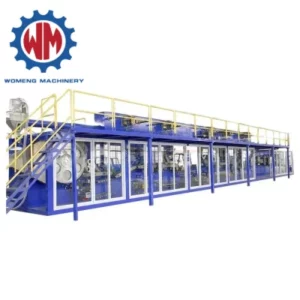January 20, 2024
How is the baby diaper making machine cleaned and maintained for optimal performance?
Cleaning and maintaining a baby diaper making machine is crucial for optimal performance, longevity, and the production of high-quality diapers. Regular maintenance helps prevent breakdowns, ensures efficient operation, and extends the lifespan of the equipment.
Here are general steps involved in cleaning and maintaining a baby diaper making machine:
- Daily Cleaning Routine:
- Establish a daily cleaning routine to remove dust, debris, and residual materials from the machine. This may involve using compressed air, vacuuming, or brushing to clean various components.
- Material Residue Removal:
- Regularly clean and remove any residue, such as adhesive or SAP (Super Absorbent Polymer), from critical parts like cutting blades, rollers, and sealing mechanisms. This helps prevent buildup that could affect machine performance.
- Lubrication:
- Apply lubrication to moving parts and components that require it. Lubrication helps reduce friction, prevent wear and tear, and ensures smooth operation. Follow the manufacturer’s recommendations for the type and frequency of lubrication.
- Inspect Wear Parts:
- Regularly inspect wear parts such as cutting blades, rollers, and belts for signs of wear. Replace any worn or damaged parts promptly to maintain optimal performance.
- Check Tension Systems:
- Inspect and adjust tension control systems to ensure that materials are fed through the machine with the correct tension. Proper tension control is essential for preventing material distortions and maintaining consistent product quality.
- Calibration:
- Periodically calibrate the machine to ensure that it operates within specified tolerances. This includes checking and adjusting settings related to cutting dimensions, material thickness, and other critical parameters.
- Sensor Calibration:
- If the machine uses sensors for monitoring and control, calibrate these sensors regularly to ensure accurate readings. This is particularly important for sensors related to tension, thickness, and quality control.
- Inspect Electrical Components:
- Check electrical components, wiring, and connections for signs of wear, damage, or loose connections. Ensure that all electrical systems are functioning properly and replace any faulty components.
- Cleaning Ink Systems (if applicable):
- If the machine involves printing on diapers, ensure that ink systems are cleaned regularly. Follow proper procedures for flushing ink lines and maintaining print heads.
- Inspect Pneumatic Systems:
- If the machine uses pneumatic systems, inspect air hoses, valves, and pneumatic components for leaks or damage. Address any issues promptly to maintain reliable operation.
- Review Safety Features:
- Regularly review and test safety features of the machine, such as emergency stop buttons and safety interlocks. China baby diaper making machine manufacturers Ensure that these features are functioning correctly to guarantee a safe working environment.
- Document Maintenance Activities:
- Maintain comprehensive documentation of all maintenance activities. Record dates, tasks performed, and any issues identified and addressed. This documentation helps track the machine’s maintenance history and informs future planning.
- Training for Maintenance Personnel:
- Provide training for maintenance personnel to ensure they are skilled in performing routine maintenance tasks, troubleshooting issues, and conducting more extensive repairs when necessary.
- Scheduled Preventive Maintenance:
- Establish a scheduled preventive maintenance plan that includes routine checks and tasks. Adhering to a preventive maintenance schedule helps identify and address potential issues before they escalate.
- Collaboration with Manufacturer Support:
- Establish a relationship with the machine manufacturer or supplier for technical support and guidance. This collaboration can provide access to expert advice, spare parts, and updates on best practices for machine maintenance.
By implementing a comprehensive cleaning and maintenance routine, manufacturers can optimize the performance of their baby diaper making machines, reduce downtime, and ensure the production of high-quality diapers. Regular attention to maintenance not only enhances efficiency but also contributes to the overall reliability and longevity of the equipment.

